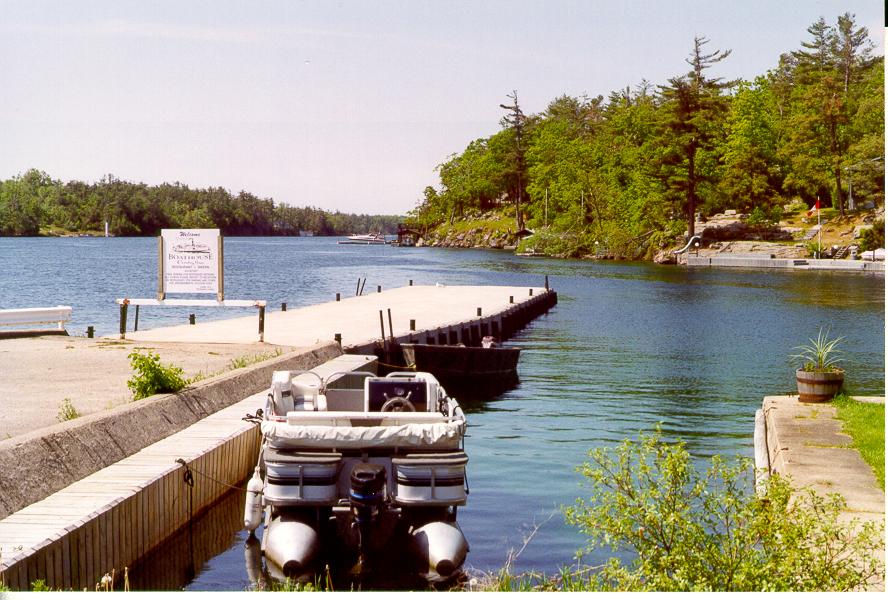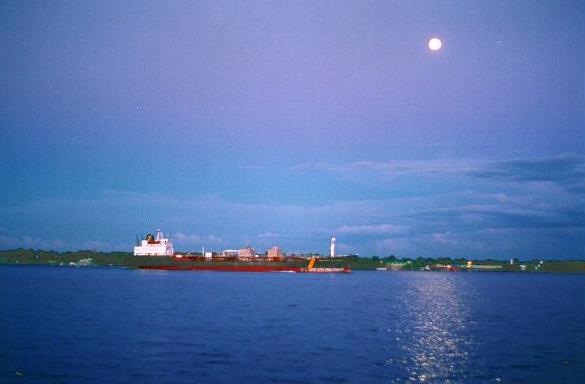

Before I start telling you of the joys of St. Lawrence River diving, you may want to visit the Multi-Lingual Scuba Dictionary or find out more about the author of these pages, Robert Wood.
The above picture is at Rockport looking upstream to where the famous Rockport Wall dive is. Entry is from the quay in the picture; the local restaurant owner charges you $10 for the privilege of parking and diving off the quay. Interestingly, although one starts the dive by swimming upstream, in fact you are swimming in the same direction as a slight current due to a very large eddy in the area. This picture was taken in September when there was no boat traffic. Ordinarily, diving here is out of the question between June 1st. and September 1st due to the heavy boat traffic. To the right is a marina and a hotel.
The St. Lawrence river forms part of the border between Canada and the US. It is a long river flowing from Lake Ontario through Montreal to the estuary in the province of Quebec, ending with the Island of Newfoundland. It is a very large estuary. The water is fresh upstream of Quebec city, thus you will find yourself less buoyant than in the ocean. The estuary has mixed fresh/salt conditions which varies from place to place. There is some excellent diving in the estuary, especially LesEscoumins and the wreck of The Empress of Ireland.

However, my diving is in the section of river between Kingston and Cornwall, which also is part of the St. Lawrence Seaway which takes ocean going vessels to the Great Lakes; this provides us with some interesting boat traffic to contend with as this photograph from Prescott Docks shows.
A hydroelectric dam was constructed at Cornwall, flooding a large area upstream, as far as Cardinal, flooding whole towns, which now offer some unique dive sites. The Thousand Islands region of the river, at the effluence of Lake Ontario, contains many islands formed by the rock of the Canadian shield as it sweeps South to form the Addirondacks in up-state New York. This area has summer temperatures regularly into the 80s and lots of sunshine. It really is a northern riviera and not crowded or polluted.
The diving season, for most people, is from April/May to October. During the winter months, the shipping channel is closed. However, the river doesn't always ice over between Kingston and Cornwall and hardy drysuiters sometimes take the opportunity to dive in the shipping channels during the winter months. Us wet suiters may come out for a dive off Prescott Docks on New Year's day, but in general winter is barren.
Due to the mixing of the water flow, the temperature within the river is uniform, varying throughout the season from 50F -> 75F -> 50F. From November to April, the temperature is 45F -> 32F -> 45F . The actual weather conditions, including water temperatures, can be obtained from the NOAA buoy at Alexandria Bay.. In Lake Ontario, up to and including the Wolf Islander wreck, there is a thermocline which, at the height of the season, is at about 55'-60'. Above that, the temperature tracks that of the river; below it is a more or less constant 50F-55F during the season. These extreme variations in temperature have an impact upon choice of thermal protection and thus buoyancy
In the river, current conditions can vary immensely, even from day to day for any particular site. This depends upon the amount of recent rain, storm conditions and the use of the dams in the river. There is negligible current in Lake Ontario. There are sites with zero current and others with strong current, > 4 knots. Famous strong current sites are Lilly Parsons, Lock 21, Daryaw and various river drifts. These make some excellent drift diving but also require some physical effort and river technique.
Viz varies from site to site but, in season, is generally between 25'-45'. There are daily variations, depending upon rain, storm, etc. Thus, Lock 21 is a notoriously bad viz site - 15' being considered good there. I had 85' a couple of times last season but that is exceptional - and wonderful. On New Year's Day, we had 60 foot visibility off Prescott Docks. This site is a common training site and usually we get 25 feet viz if we are lucky. Also, in the lake, above the thermocline, the viz is poor at the height of the season due to algae bloom. Below the thermocline, it is a good 30' - 45'.
I thought I'd include this photo here to give you an idea of what many dive boats are like in this region. Most sites are within a few minutes from shore and the weather is pretty good in season. The only problem to watch for is when the wind blows from the South-West right down the river. Then there is effectively a small craft warning as waves can quickly be whipped up to 6 feet. Off Kingston, Lake Ontario, the situation is worse and the on-shore South-Westerly arrives as regular as clockwork every afternoon; so diving is a morning activity in Kingston.
Fish are pike, muskellunge, eel, carp, bass, catfish, etc. but the area is not known for its diverse and abundant life. However, it's always good to see a pike eat a fish. Water visibility has been immensely improved over the past few years by the arrival of the famous Zebra Mussel. This alien creature has forced out local fresh water mussels but not affected the rest of the critter population. It has even improved aquatic plant life, which had been affected by pollution over the years. It will cut your wet suit to threads though, if you have the tendency to bounce along the bottom. As usual, good buoyancy control is required.
There are plenty of different diving sites - wrecks, walls, drifts and even submerged power stations, locks and other terrestrial structures. Some sites are shore access but many require a boat. Depths are typically 30'; 60'-100' and real deep. These deep sites and wreck penetrations provide plenty of opportunities for technical diving. The village of Rockport is noted for it's deep sites - Rockport Wall to 240' and the wreck of the Jodery - starts at 130' and goes to 240'.
Popular shore dives are Rothesay, Conestoga and Prescott docks (for novice and out-of-season dives), Rockport and Lock 21. Note, Lock 21, although only 60 feet max depth, is an advanced dive due to the poor viz and strong current. Popular boat dives are Wolf Islander, Marsh, Keystorm, Kingshorn, America, Vickery, etc. Architectural sites include various submerged shipping locks and the old Mille Roches hydro-electric generating power house.
If you are considering a visit, then this list of shops, charters and clubs will be of assistance.
Maybe I'll see you in the St. Lawrence this year.
EMERGENCY NUMBERS AND CONTACT INFO:Just a note to point out that the whole St. Lawrence is covered by analogue cell phone service. Digital service is currently limited.Emergency police, ambulance, fire 911
Ottawa Hyperbaric Chamber 613 737-800
Montréal Hyperbaric Chamber 514 338-2777
DAN 1-800-326-3822 (1-800-DAN-EVAC)
Trenton Coastguard 1-800-267-7270Marine Radio hail channel 16
Fill my tank, I said *^#%*!!!!!!!!!
-